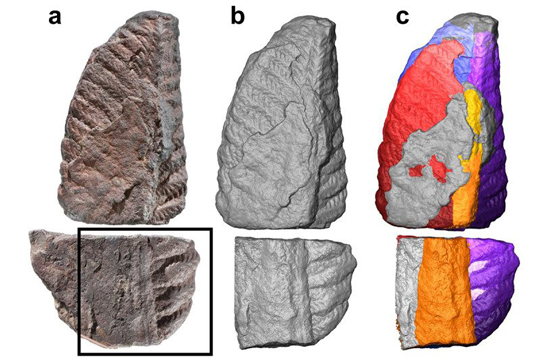First Non-Destructive Internal Images of Rangea
Travel back in time far enough and the distinction between what is a plant and what is an animal becomes blurred. For a palaeontologist, unravelling the mysteries of the origins of multi-cellular life is daunting. Firstly, when examining the few fossils of multi-cellular organisms known from rocks laid down in the Proterozoic Eon, what strikes you is the paucity of the fossil record, in essence there is very little fossil evidence to study. Secondly, some of the lifeforms represented are so bizarre that there is nothing alive today that can begin to provide scientists with any hints as to structure, form, lifestyle or behaviour.
However, an international team of scientists, writing in the journal of “Precambian Research”, have conducted a remarkable assessment on three-dimensionally preserved Ediacaran fossils and they have shed light on the evolution of complex life. The organism in question is Rangea, a bizarre fern-like animal/plant/? that did not possess bilateral symmetry like us, or indeed radial symmetry like starfish and sea urchins, but a fractal structure, like nothing alive today.
The Fossil and Internal/External Scans of a Three-dimensionally Preserved Rangea Specimen
Picture credit: Precambrian Research
The picture above shows the fossil (a), a computer-generated model of the external structure (b) and a computer-generated model of the internal structure of Rangea (c).
High Resolution X-ray Micro-computed Tomography
At Everything Dinosaur, we suspect that the fossil specimens come from rocks laid down in shallow, marine sediments that make up the Nama Group in southern Namibia. Rangea is known from this location and has also been reported from other Ediacaran-aged sites in Australia and Russia. The Namibian material is remarkable as the fossils are typically moulds and casts of the fern-like structures, preserved in ironstone nodules, which despite representing lifeforms that existed somewhere between 540 and 580 million years ago, have not been squished and deformed to a huge extent as a result of the fossilisation process and the enormous time these fossils have existed in the strata.
The scientists used high resolution X-ray micro-computed tomography (microCT) to investigate the 3-D internal morphology of these exceptional fossils. This is the first non-destructive internal imaging of Rangea. Ranging from a few centimetres to tens of centimetres in length, the soft-bodied Rangeomorphs (a natural taxon, established to help classify these frond-like, fractal organisms), are perhaps best known to fossil fans in the UK as organisms similar in structure to Charnia, named and described from a single fossil specimen found in Charnwood Forest, Leicestershire by a school boy in 1957.
A Specimen of a Fern-like, Soft-bodied Charnia
Picture credit: Everything Dinosaur
Analysing the Results of the Pre-Cambrian Fossil Study
Lead author of the study, Dr Alana Sharp (School of Science and Technology, University of New England, New South Wales, Australia) and her colleagues think that all six fronds may have been inflated like long balloons, they may have touched each other creating a large surface area for the passive absorption of nutrients which sustained the organism. It had been thought that these fronds, regarded as some form of feeding structure, were flat.
Dr Sharp commented:
“Our work supports a lifestyle of absorption of nutrients through membranes inflated to the maximum, increasing the surface area across which these organisms seemed to feed.”
Soft Bodies but Stone Hearts
The CT scans also revealed something else about Rangea. It had a cone-shaped channel running vertically up its central trunk. The lower part of this channel seems to have been filled with sediment that has a different composition from that seen in the rest of the fossil. The researchers have concluded that this was probably present in the organism when it was alive, helping to prevent it from buckling or being compressed. The sediment acted like internal scaffolding for Rangea, a sort of primitive skeleton. These findings support the idea that Rangea was benthic (lived on the sea floor) and that it was probably sessile (attached to the sea floor and immobile).
Despite these remarkable computer-generated images, one big mystery remains, as Dr Sharp explains.
“They may or may not be animals, we can’t say from this study. But they are the first of the truly large, multi-cellular organisms that radiated broadly before the first true animals evolved.”
The Scientific Paper: “First non-destructive Internal Imaging of Rangea, an Icon of Complex Ediacaran Life” by Alana C. Sharp, Alistair R. Evans, Siobhan A. Wilson and Patricia Vickers-Rich, published in the journal “Precambrian Research”.
Visit the Everything Dinosaur website: Everything Dinosaur.








Leave A Comment